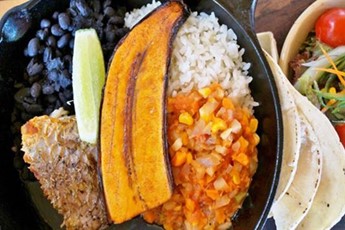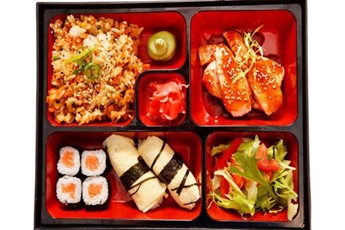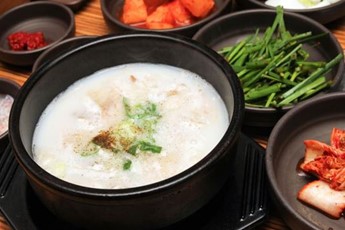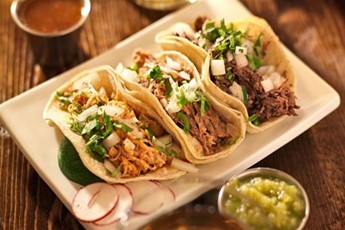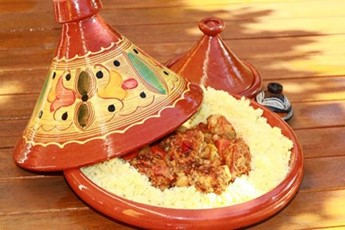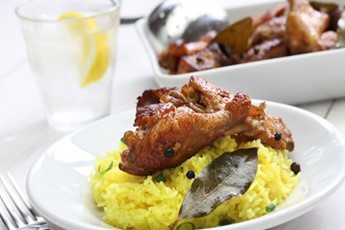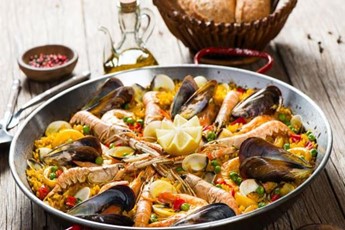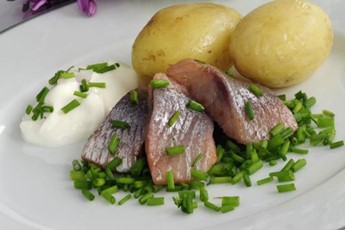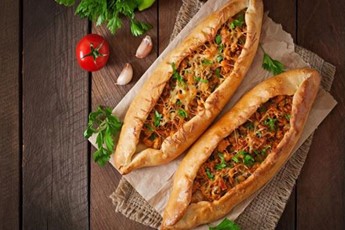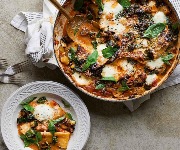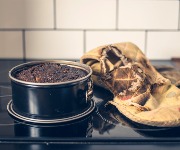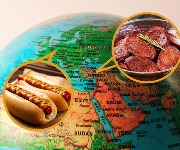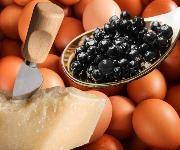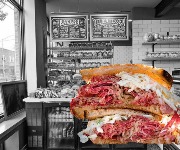What lunch looks like around the world

Mouthwatering lunches from Australia to America and Jamaica to Japan
Take an appetising tour around the globe to discover what different nations like to eat for lunch.
Argentina
In Argentina, aside from sandwiches de miga (delicate sandwiches), empanadas – pastries filled with meat, seafood or vegetables – are prevalent, as are steamed tamales or locro, a filling soup.
Australia
For lunch, a packed lunch of sandwiches or leftovers is the norm, or many people visit food courts where there’s a variety to choose from; Asian cuisine is especially popular. Seafood and barbecued meat are also widely consumed.
Brazil
Lunch (almoço) is an important meal in Brazil. Though the food varies from region to region, rice and beans are most often eaten, along with eggs or meat. Churrascaria barbecue restaurants are popular, as are ‘por quilo’ self-service restaurants.
Canada
Salad, sandwiches and soup are usually the order of the day for Canadians. Alternatively, they will visit food courts to eat, where there’s a range of cuisines to choose from – burgers and Asian cuisine are particularly popular.
China
Rice and noodles are staples in China and will be eaten at most meals. It depends on the region, but expect people to eat noodle soup, dumplings, or street food consisting of an array of dishes such as Chinese crepes.
Colombia
Like many Spanish-speaking countries lunch is the most cherished meal of the day in Colombia – three courses are common: usually soup or salad, followed by a hot main and a dessert. Typical Colombian dishes include arepa (cornmeal bread), ajiaco (chicken and potato soup) and sancocho (stew).
EQRoy/Shutterstock
Costa Rica
Casado, a platter of rice and beans that's often served with plantain, meat and vegetables is a standard lunchtime dish in this Central American country. Gallo pinto (rice and beans but mixed together) is also served throughout the day, though it’s generally regarded as a breakfast dish.
Denmark
The Danes are very partial to smørrebrød (open sandwiches) which usually consist of rye bread topped with fish, seafood, meat or pickled vegetables.
France
If eating out, the French will often opt for the menu du jour: three courses of a starter of soup, salad or pate; a main of meat or fish with rice, pasta or vegetables; and a dessert of fruit tart or ice cream. For something lighter, a ham or cheese-filled baguette or omelette is common.
P Burghardt/Shutterstock
Germany
The typical German lunch of meat, potatoes and vegetables has been replaced by lighter dishes over the years – hungry diners tend to grab some soup, pasta, baked sausage meat called leberkäse, or a sausage with bread.
Greece
Tastes have also changed in Greece. Where once families sat down to a stew now people are more likely to opt for a salad or sandwiches. A baked dish such as moussaka is eaten when something more substantial is required.
Iceland
Icelandic cuisine is unique in many ways: rotting shark, whale and puffins are all eaten, although lamb-based hot dogs are enjoyed and lamb and fish is popular. Meat and potatoes, followed by fruit soup, is a typical lunch meal.
India
Tiffin lunches are widespread in India (tiffins are interconnecting lunch boxes that contain a number of dishes). These are either made up at home or by street vendors. The contents vary but there’s usually rice, some sort of Indian bread such as roti, vegetable curry, pickles and dal.
Italy
A traditional Italian lunch will involve a first course (primo) of pasta (pictured) or risotto, and a second course (secondo) of fish or meat with vegetables or salad.
Jamaica
During the week, a patty is a common lunch food. It’s eaten with coco bread, which is made with coconut milk and is slightly sweet.
Shebeko/Shutterstock
Japan
In Japan there are a number of options available at lunchtime, though bento boxes and ramen are arguably the most popular. Bento boxes can include sushi, rice, tempura, pickles and a hot or cold dish of meat, fish, tofu or vegetables, and are eaten with miso soup.
Kenya
Stew is a regular sight on Kenyan menus and is eaten everywhere. Stews are usually made with meat, potatoes and vegetables and served with ugali (cornmeal starch), chapatis or rice.
KYTan/Shutterstock
Korea
Korean meals are a soup or stew, or rice with banchan – these are small dishes that accompany rice and include kimchi (fermented veg), bokkeum (stir-fried dishes with sauce), and jeon (pancakes).
Joshua Resnick/Shutetrstock
Mexico
Mexican lunches are leisurely affairs that start with a salad or soup, followed by rice and beans with meat, fish or vegetables and tortillas. For people on the go, tacos (pictured) are a go-to staple.
NCAimages/Shutterstock
Morocco
Lunch in Morocco is considered the main meal of the day, and can be drawn out. A meze of salads and olives is usual, as is a main course of tagine and couscous (pictured above). Mint tea is drunk afterwards.
Nigeria
Jollof rice with suya (spiced grilled meat) is commonly eaten in this African country, as is an array of soups, depending on the region. Sides of yams, cassava and plantain are the norm.
bonchan/Shutterstock
Philippines
Filipino food is diverse and abundant. Rice is nearly always served, alongside the likes of adobo (braised pork or chicken, pictured) or sinigang (seafood or meat in a hot and sour broth).
Russia
If you’re dining in a restaurant in Russia at lunchtime expect to eat soup – hot in winter, cold in summer – such as borscht, as well as meat in the form of stroganoff or meatballs, and potatoes or pasta. Kompot is a common post-lunch drink; it’s made of berries and sugar boiled in water.
Saudi Arabia
Meat is generally eaten at lunch in Saudi Arabia and is usually lamb or chicken (pork is forbidden under Islamic law). Meat skewers (kultra) are widely eaten, alongside pitta bread and tabbouleh. Mezze and hummus are also regularly consumed.
Iryna Denysova/Shutterstock
Spain
Spaniards enjoy a long lunch, though this is changing in big cities where a sandwich or salad is more likely to be eaten. A traditional lunch begins with soup or salad, then a dish such as paella, cod in tomato sauce, or meat stew. Dessert is often flan, a pastry or fruit. Tapas is generally eaten between work and dinner, not lunch.
Rikard Stadler/Shutterstock
Sweden
Fish is popular in this Scandinavian country especially herring and salmon, which is served with bread or potatoes. Salads are also widely eaten.
Kidsada Manchinda/Shutterstock
Thailand
Like most Asian countries, Thai dishes aren’t confined to a particular time of day. Pad Thai (pictured) is an example of a popular meal, as well as Thai curries and tom yum soup, while street vendors sell a dizzying array of options.
Timolina/Shutterstock
Turkey
Meze, gozleme (layered vegetable cheese pastry), kebabs, kofte (meatballs) and pide (the Turkish version of pizza, pictured), as well as a range of soups, are typical lunch fare in Turkey.
USA
Because of its cultural diversity, especially in the cities, there are a number of cuisines on offer in the States. Americans tend to eat leftovers, soups, salads or deli sandwiches (also known as subs), or eat tacos, or pasta and pizza in their break.
senlektomyum/Shuterstock
Vietnam
Like Thailand, lunch in Vietnam doesn’t differ that much from breakfast or dinner – noodles and soup are commonplace, as are spring rolls with dipping sauce (pictured). The Vietnamese version of a sandwich is banh mi, a baguette traditionally filled with meat, pate and pickled vegetables.
You might also enjoy:
Here's what breakfast looks like around the world
Ten things you didn't know avocado could do
How to cook with edible flowers
Best food photos in the world from the Pink Lady Food Photographer of the Year 2016
Most Recent
Comments
Be the first to comment
Do you want to comment on this article? You need to be signed in for this feature
